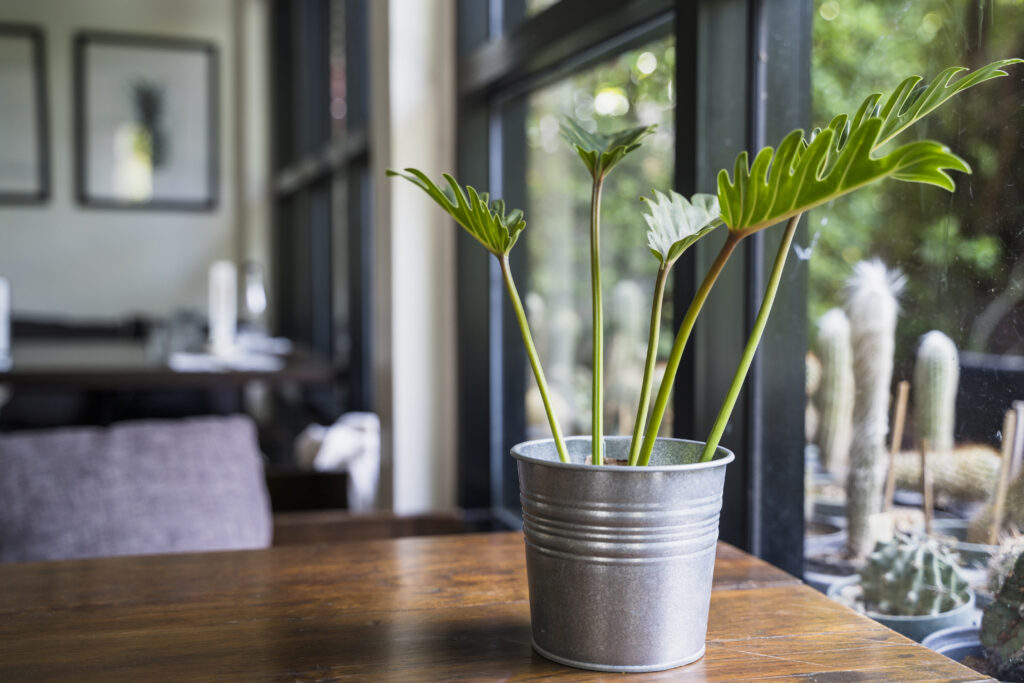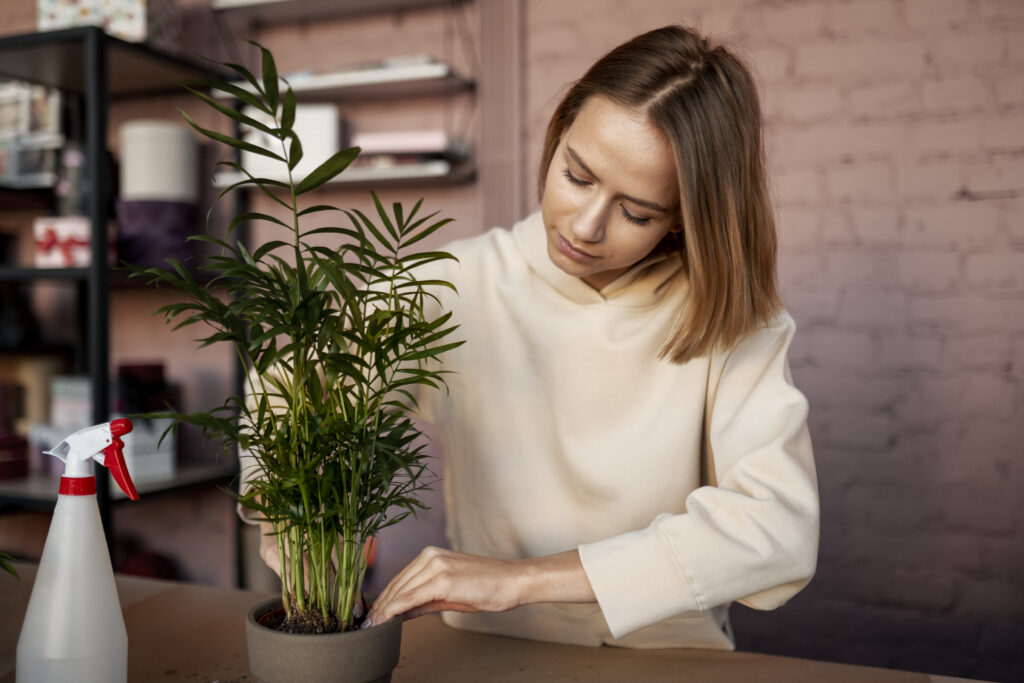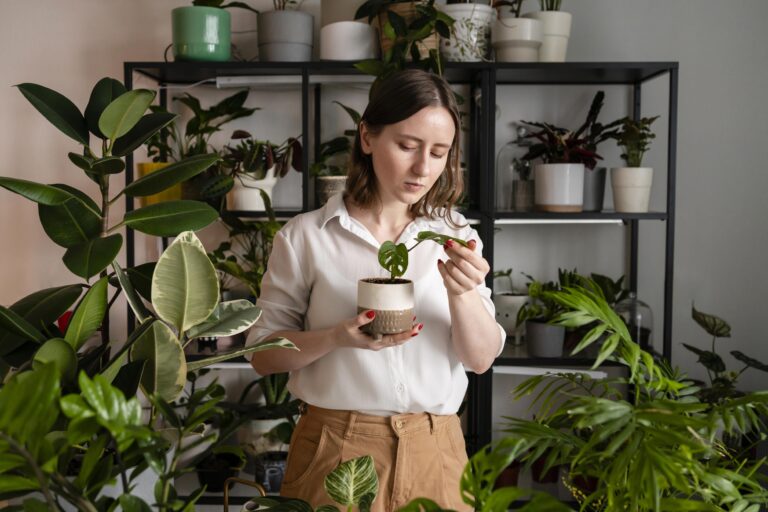Contents
Introduction
If you’re a proud plant parent, you know how rewarding it is to see your indoor plants thrive. But nothing can put a damper on your green thumb like discovering pesky little critters munching on your precious leaves. Whether you’re dealing with tiny bugs or fuzzy white spots, pests can quickly become a major headache.
Indoor plant pests are more common than you might think, and they can sneak in on new plants, be carried in from the outside, or even show up as a result of poor plant care. The good news is that identifying and treating these unwelcome guests doesn’t have to be complicated. With a bit of know-how, you can keep your plants healthy and pest-free.
In this guide, we’ll break down everything you need to know about common indoor plant pests and how to handle them. We’ll cover the types of pests you might encounter, how to spot the signs of an infestation, and easy, effective ways to tackle these problems. Whether you’re new to indoor gardening or just looking for some extra tips, we’ve got you covered.
So, grab a cup of coffee, and let’s dive into the world of indoor plant pests. By the end of this guide, you’ll be well-equipped to keep your plants happy and healthy, and you’ll have a lot fewer uninvited guests!
Understanding Indoor Plant Pests
Let’s face it—no one likes dealing with pests, especially when it comes to our beloved indoor plants. But before you can get rid of these little intruders, it’s important to understand what they are and how they operate. This section will walk you through the basics of indoor plant pests, from what they are to how you can spot them before they become a big problem.
Definition and Types of Pests
Indoor plant pests come in a few different varieties, and each type has its own unique quirks. Here’s a quick rundown:
- Insects: These are the most common culprits and include little bugs like aphids, spider mites, and whiteflies. They might be tiny, but they can do a lot of damage if you don’t catch them early.
- Mites and Other Arachnids: These are similar to insects but have a different number of legs. Spider mites, for example, are very small and can create fine webbing on your plants. They’re sneaky and can be hard to spot until they’ve done some serious damage.
- Fungal and Bacterial Pests: These aren’t bugs but are still pests that can harm your plants. Fungi and bacteria can cause things like mold and rot, which can be just as problematic as any insect.
Signs of Pest Infestation
Knowing what to look for is half the battle. Here are some common signs that your plant might be dealing with pests:
- Visual Indicators: Keep an eye out for things like holes in leaves, unusual webbing, or sticky spots. Sometimes pests leave behind telltale signs like tiny black specks or white fuzz.
- Plant Health Changes: If your plant’s leaves start turning yellow, curling up, or falling off, it might be a sign of a pest problem. Stunted growth or wilting can also point to an infestation.
By understanding the different types of pests and the signs of an infestation, you’ll be in a much better position to act quickly and keep your plants looking their best. In the next section, we’ll dive into how to identify these pests more specifically and what you can do about them.
Identifying Common Indoor Plant Pests
If you’ve ever found tiny bugs on your plants and wondered what they are or how to get rid of them, you’re not alone. Identifying the specific pest is key to choosing the right treatment and keeping your indoor garden healthy. Here’s a handy guide to the most common indoor plant pests and how to spot them.
Aphids
Aphids are tiny insects that come in various colors, including green, black, and brown. They often look like little bumps on your plant’s leaves or stems. Here’s what to watch for:
- Appearance: Aphids are soft-bodied and can be as small as 1/8 inch long. They often cluster together, making them easier to spot.
- Symptoms: If you see leaves curling or turning yellow, or if there’s a sticky substance (known as honeydew) on your plants, aphids might be the problem. They also leave behind a sooty mold that can further damage your plants.
Spider Mites
Spider mites are not true spiders but tiny arachnids that can be difficult to see without a magnifying glass. They’re known for their destructive feeding habits.

- Appearance: These mites are so small they might look like tiny moving dots. They’re usually red, yellow, or green and may leave behind fine webbing on your plants.
- Symptoms: Look for speckled or stippled leaves that might also be dusty or web-covered. If you notice fine webbing, especially under the leaves, it’s a sure sign of spider mites.
Whiteflies
Whiteflies are tiny, winged insects that can quickly become a nuisance if not dealt with promptly. They’re particularly fond of indoor plants.
- Appearance: These pests are small, white, and look like tiny flying moths. They tend to fly up in a cloud when you disturb the plant.
- Symptoms: You might notice yellowing leaves and sticky residue (honeydew) on the plant or nearby surfaces. Whiteflies also cause leaves to become stippled or distorted.
Mealybugs
Mealybugs are another common pest that resembles little white cotton balls or masses on your plants.
- Appearance: They’re covered in a white, waxy substance that makes them look like tiny pieces of cotton.
- Symptoms: Mealybugs cause leaves to wilt and can create a sticky residue. They’re often found in clusters, hiding in the leaf axils or on the stem.
Scale Insects
Scale insects are small and can be either soft or hard. They can be tricky to identify because they often blend in with the plant.
- Appearance: They look like small, oval bumps that can be brown, black, or gray. Some have a waxy coating.
- Symptoms: Look for yellowing leaves and a general decline in plant health. Scale insects often leave behind a sticky residue and cause the plant to become weak and stunted.
By knowing what each pest looks like and understanding their symptoms, you can more easily diagnose the issue and choose the best treatment. In the next section, we’ll dive into how to treat these pests and prevent future infestations.
Treatment and Prevention Strategies
Now that you know how to identify the common pests that might be troubling your indoor plants, it’s time to tackle them head-on. Dealing with plant pests might seem daunting, but with the right strategies, you can manage and even prevent these issues. Let’s dive into the best ways to treat and keep those pesky invaders at bay.

Chemical Treatments
Sometimes, when pests are really causing havoc, you need to pull out the big guns. Here are some effective chemical treatments:
- Insecticidal Soaps: These are specially formulated soaps designed to kill soft-bodied insects like aphids and whiteflies. They work by breaking down the pests’ outer shells, causing them to dry out and die.
- Use: Apply directly to the pests. Be sure to cover the entire plant, especially the undersides of leaves where pests often hide.
- Application: Follow the instructions on the label for how often and how much to use. Overuse can harm your plant, so stick to the recommended amounts.
- Neem Oil: Neem oil is a natural product derived from the seeds of the neem tree. It works as an insecticide, fungicide, and miticide, making it a versatile option for pest control.
- Use: It disrupts the life cycle of pests and can help control various types of insects and fungi.
- Application: Spray it on affected areas. It’s best to apply neem oil in the early morning or late evening to prevent leaf burn. Avoid applying it in direct sunlight.
- Systemic Insecticides: These are chemicals that plants absorb through their roots or leaves, making the entire plant toxic to pests. They’re usually used for severe infestations.
- Use: These are more potent and should be used when other methods aren’t effective.
- Application: Follow label instructions carefully, as overuse can be harmful to both your plants and the environment.
Non-Chemical Treatments
If you prefer more natural or less harsh methods, here are some non-chemical treatments:
- Manual Removal: Sometimes, the best approach is the simplest. If you notice a few pests, you can often remove them by hand or with a gentle water spray.
- Method: Use tweezers or a soft brush to pick off larger pests. For smaller pests, a strong stream of water can help dislodge them.
- Best For: Small infestations or pests like mealybugs that are easy to spot and remove.
- Natural Predators: Introducing natural predators into your plant environment can help control pest populations without chemicals.
- Examples: Ladybugs are great for aphids, and predatory mites can help with spider mites.
- Application: Release these beneficial insects onto your plants. They’ll naturally prey on the pests and help keep their numbers down.
- Homemade Remedies: If you enjoy DIY solutions, there are several homemade remedies you can try.
- Examples: You can make a simple insecticidal soap with dish soap and water or use garlic sprays to repel pests.
- Application: Apply these remedies directly to affected areas. Always test a small area of your plant first to ensure it won’t cause damage.
Preventive Measures
The best way to handle plant pests is to prevent them from showing up in the first place. Here’s how to keep your indoor garden in tip-top shape:
- Regular Monitoring: Keep a close eye on your plants. Regularly inspect them for signs of pests or disease.
- Method: Check both sides of leaves and the stems. Use a magnifying glass if needed to spot tiny pests.
- Tools: A small flashlight can also help in spotting pests, especially in the crevices of plants.
- Maintaining Plant Health: Healthy plants are less likely to attract pests. Make sure your plants are getting the right amount of water, light, and nutrients.
- Practices: Water plants according to their needs, ensure they’re getting enough light, and use quality potting soil.
- Benefits: Strong, healthy plants are more resilient to pests and diseases.
- Isolation of New Plants: When you bring new plants home, keep them separate from your existing collection for a few weeks.
- Method: Quarantine new plants in a different room or area.
- Purpose: This helps prevent any potential pests or diseases from spreading to your other plants.
By combining these treatment and prevention strategies, you’ll be well-equipped to handle any pest problems that come your way. In the next section, we’ll look at some real-life examples of pest management to give you a clearer idea of how these methods work in action.
Case Studies and Examples
Real-life examples can provide valuable insights into how different pest management strategies work. Here are a few case studies that showcase how various methods can be used to tackle common indoor plant pest issues. These examples will help illustrate how to apply the strategies we’ve discussed and achieve successful outcomes.
Example 1: Aphid Infestation
Aphids are notorious for their rapid reproduction and damage to plants. Here’s a look at a case where an aphid infestation was managed effectively.
- Description: A plant enthusiast noticed that their indoor rose plant was covered in tiny, green insects (aphids). The leaves were curling and turning yellow, and there was a sticky residue on the leaves and nearby surfaces.
- Treatment: The gardener decided to start with a simple solution—using insecticidal soap. They applied it to the affected areas of the plant, ensuring they covered both the tops and undersides of the leaves.
- Outcome: After a few applications, the aphid population was significantly reduced. The plant began to recover, with new, healthy leaves emerging. The gardener also added a few ladybugs to the plant as a preventative measure, which helped keep aphids away in the future.
Example 2: Spider Mite Outbreak
Spider mites can be particularly challenging due to their tiny size and ability to quickly spread. Here’s how a spider mite outbreak was managed.
- Description: A home gardener noticed that their spider plant had fine webbing and spotted leaves. Upon closer inspection, they discovered a severe spider mite infestation.
- Treatment: The gardener first tried using a strong water spray to dislodge the mites. Since the infestation was extensive, they also used neem oil as a follow-up treatment to target the remaining mites and prevent further damage.
- Outcome: The combination of water spraying and neem oil proved effective. The webbing disappeared, and the plant’s health improved. The gardener also improved air circulation around the plant, as spider mites thrive in dry conditions.
Example 3: Whitefly Control
Whiteflies are persistent pests that can be difficult to eliminate once they’ve settled in. Here’s a case study showing how to handle a whitefly problem.
- Description: An indoor gardener noticed that their ficus plant had a cloud of small white insects flying up whenever the plant was disturbed. The leaves were also turning yellow and dropping off.
- Treatment: The gardener used a combination of insecticidal soap and yellow sticky traps. The sticky traps helped catch the adult whiteflies, while the soap targeted the nymphs and eggs.
- Outcome: The dual approach was successful in managing the whitefly infestation. The sticky traps caught a significant number of the adult insects, and the soap treatment reduced the population of nymphs and eggs. The ficus plant showed noticeable improvement and started growing new, healthy leaves.
Conclusion
Managing indoor plant pests might seem like a daunting task, but with the right knowledge and strategies, it’s entirely manageable. By understanding the types of pests you might encounter and recognizing the signs of an infestation, you can act quickly to protect your plants. Here’s a quick recap of what you’ve learned and some final tips to keep your indoor garden in top shape.
Summary of Key Points
- Identify the Pests: Knowing what kind of pests you’re dealing with is crucial. From aphids to whiteflies, each pest has its own set of characteristics and symptoms. Identifying them early will help you choose the most effective treatment.
- Treatment Options: You have a range of treatments at your disposal, from chemical solutions like insecticidal soap and neem oil to non-chemical methods such as manual removal and natural predators. Each method has its pros and cons, so selecting the right one depends on the severity of the infestation and your personal preferences.
- Preventive Measures: Prevention is always better than cure. Regularly monitor your plants, maintain their health through proper care, and isolate new plants before introducing them to your collection. These steps can help you avoid infestations and keep your indoor garden flourishing.
Final Tips
- Act Quickly: The sooner you spot and address a pest problem, the easier it will be to control it. Regular checks and early intervention are key to preventing serious damage.
- Be Patient: Some treatments take time to work. Be patient and follow the instructions carefully. It might take a few rounds of treatment before you see significant improvement.
- Stay Informed: Indoor gardening is a learning process. Keep yourself updated with the latest pest control methods and plant care tips. The more you know, the better equipped you’ll be to handle any issues that arise.
Final Encouragement
With these tools and techniques in your gardening toolkit, you’re well on your way to becoming an expert at managing indoor plant pests. Remember, every plant and situation is unique, so don’t be afraid to experiment and find what works best for you. Happy gardening, and may your indoor plants continue to thrive and bring joy to your home!



